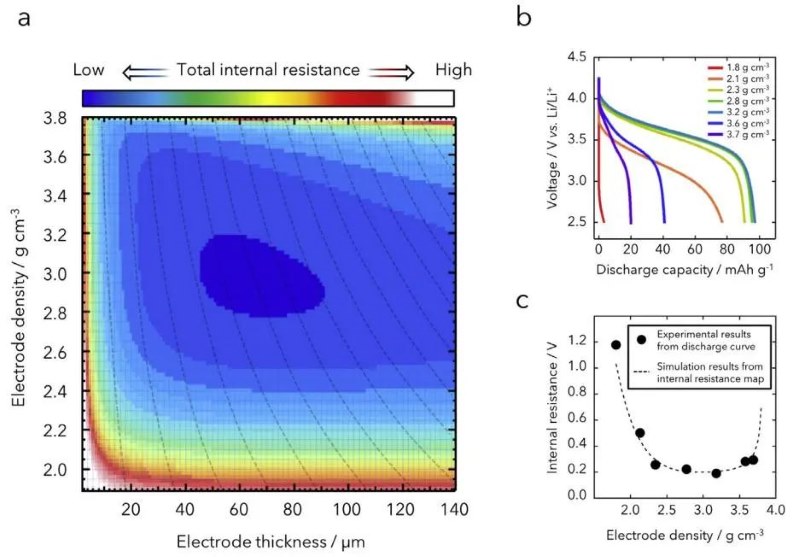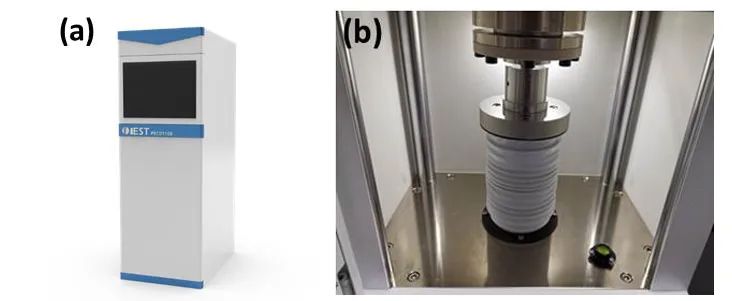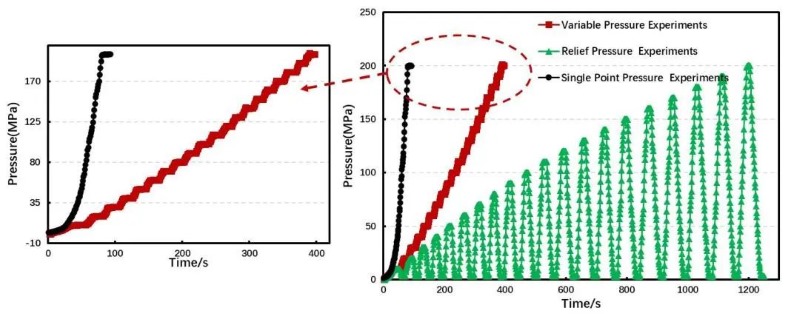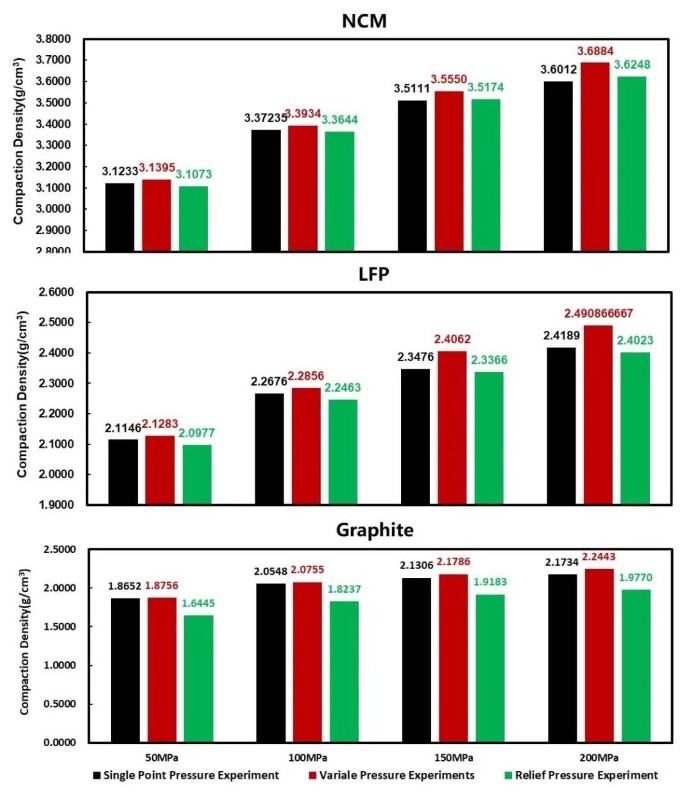Analysis of Factors Influencing Powder Compaction Density Measurement - Pressing Method
The lithium-ion battery industry is one of the important directions affecting the development of the national economy at present. In the design and research process of lithium-ion batteries, compaction density is one of the key indicators affecting battery performance. The level of compaction density is closely related to the particle size and distribution of the key main material, the positive and negative electrode powder, and is closely related to the capacity, battery internal resistance, and battery life. The study of compaction density includes two directions of electrode density and powder density. For the evaluation of the compaction density, the traditional method is to evaluate the electrode density, which needs to be tested through the steps of batching slurry-coating roll pressing-baking-weighing thickness measurement-calculation, and further correlates with the electrical properties of the battery, figure 1 is a schematic diagram of the relationship between electrode density, internal resistance and capacity of the battery.
The entire detection cycle of this electrode density evaluation method and method is long, and the detection efficiency is low, and the pole piece production process will also cause certain harm to personnel and the environment. Compared with the traditional method, more researchers will choose an efficient and safe positive and negative electrode powder direct compaction density measurement method to achieve it. A round die with a fixed inner diameter is used, combined with a stable and efficient pressure mechanism to compress the powder material, and a high-precision thickness measurement system is used to measure the thickness of the material, thereby achieving stable and effective measurement of the compacted density.

Figure 1. Schematic diagram of the relationship between electrode density, internal resistance and capacity of the battery
The evaluation of powder compaction density in the current design and manufacturing process of lithium-ion batteries has become an indicator that many material factories and OEMs focus on, and the stability of powder compaction density is particularly important, the measurement of powder compaction density is actually the ratio of the total mass of the tablet to the total volume after tableting. In the actual measurement process, manpower, machine, material, method, and environment are all key indicators that affect the measurement, this paper mainly combines the compaction density measurement under different pressure methods to evaluate the impact of the difference in the measurement method on the test results.
1.Test Method and Parameters
1.1Select NCM, LFP, and Graphite three materials respectively, and conduct comparative tests in three ways: single point experiment, pressure change experiment, and pressure relief experiment.
1.2Use PRCD3100 (IEST) to test the compaction density of the material, and the test equipment is shown in Figure 2. Test parameters: single-point test: 50MPa, 100MPa, 150MPa, 200MPa single-point test respectively, holding pressure for 10s; variable pressure experiment: pressure range 10-200MPa, interval 10MPa, holding pressure 10s; pressure relief experiment: 10-200MPa, interval 10MPa, release the pressure to 3MPa, hold the pressure for 10s.

Figure 2. (a) Appearance of PRCD3100; (b) Structure of PRCD3100
2.Result Analysis
In the research work of lithium-ion batteries, the monitoring of the compaction density of powder materials has been used as a key indicator of material evaluation, and has been paid attention to in many aspects such as material modification research and development, material production batch difference stability evaluation, and incoming material monitoring. Its stability in the actual measurement has attracted widespread attention. This experiment mainly evaluates the influence of the pressurization method on the determination of the compacted density by comparing the three test modes of single-point pressurization, pressure change and pressure relief. Figure 3 is a schematic diagram of pressure changes when pressurized to 200MPa under different pressurization methods, in which the single-point pressurization experiment is to directly pressurize the sample to 200MPa and keep it stable for 10s, and take the 10s results for analysis; the variable pressure experiment is to set the test parameters of 10-200MPa and hold the pressure for 10s through the software terminal, and take the data of holding the pressure for 10s at each pressure point for result analysis; The pressure relief experiment is to set 10-200MPa on the software side, release the pressure to 3MPa, hold the pressure for 10s, and take the data of the pressure relief pressure corresponding to each pressure point to the 10th second for result analysis. As shown in the figure, there are obvious differences in the pressing process and time of the samples under different pressing methods. This difference will directly affect the filling process of the powder after being pressed, and then affect the measurement results of the compacted density.

Figure 3.Schematic diagram of pressure change up to 200MPa under different pressure methods.
Figure 4 is a comparison chart of the compaction density test results of NCM, LFP, and Graphite at four pressure points of 50MPa, 100MPa, 150MPa, and 200MPa under different pressure methods, from the comparison results, there are differences in the single-point compaction density, variable pressure compaction density and pressure-releasing compaction density at each pressure point, which is mainly due to the different pressurization methods. It can be seen from Figure 3 that under different pressurization methods, there are obvious differences in the pressurization mode and time of powder materials in the actual measurement process, and the powder pressurization process is extremely complicated. In the initial stage of pressure, the porosity between the powders accounts for a relatively high proportion. As the pressure progresses, the powder particles will rearrange and slip, and finally form a relatively dense accumulation state, and the porosity between the particles decreases; As the pressure continues to increase, the powder particles themselves will undergo elastic deformation, and the porosity between the particles will not change much, but the pore size will decrease; As the pressure further increases, some powders will undergo irreversible plastic deformation, and the pore size will further decrease. At the same time, some brittle systems may also be broken, and the pore size will decrease more significantly [2].
Comparing the test results of single-point pressurization and variable pressure, there is little difference under low pressure, and the difference gradually appears with the increase of pressure. The main reason is that there are differences in the changes of powder force under the two pressurization methods. Samsung has studied the use of a two-step pressing process when rolling the pole piece. The first soft rolling process smoothly reorients the graphite perpendicular to the pressing force, thereby reducing stress and mechanical damage within the graphite and promoting uniform pore distribution throughout the electrode. The target density of the electrodes is adjusted by the subsequent second rolling. Electrodes prepared by the two-step rolling process exhibit significantly reduced springback and swelling behavior. Therefore, the variable pressure test is equivalent to multiple compaction processes, which can reduce the rebound of particles and increase the compaction density [3].
The result of comparing the unloading compaction density is obviously smaller than that of the other two pressurization methods. This is mainly because the powder pressurization process is restricted by the dual factors of elastic deformation and plastic deformation. When the large pressure loaded on the powder end is converted into a small pressure, the elastic deformation of the powder itself will overcome the small pressure and rebound, and the thickness of the powder tablet will also have obvious changes, which will cause differences in the results. In the actual testing and evaluation process of compacted density, when each laboratory needs to benchmark the performance results of samples, it is necessary to first clarify the differences in the pressurization methods during the testing process, so as to avoid erroneous comparisons and waste of time and cost.

Figure 4. Comparison of compaction density test results of NCM, LFP, and Graphite under different pressure methods
The compaction test of the powder can predict the compaction performance of the electrode, so that the electrode rolling process can be known. Researchers at the Technical University of Braunschweig in Germany established a rolling process model, which revealed the relationship between the coating density ρc and the compaction load qL [5].

Among them, ρc,max and γc can be obtained by fitting the experimental data, which respectively represent the maximum compaction density and the compaction resistance of the coating that can be achieved by the coating. These fitting parameters can be obtained through powder compaction experiments. For example, the maximum compaction density ρc,max that can be achieved by the coating is the limit value at which the powder compaction density will basically not increase in the variable pressure test experiment. The compaction resistance γc can also be obtained by fitting the compaction density results under a series of different pressures by formula. In this way, for a specific powder, the compaction density process model can be obtained, so that the electrode rolling test can be known.
3.Summary
The stable and effective evaluation of the compacted density has become the focus of the current lithium battery industry, and there are still many differences in the evaluation methods of various laboratories in the industry, in the actual evaluation and comparison process, it is necessary to conduct systematic analysis from multiple dimensions such as test principles, method differences, and influencing factors to ensure the rationality and effectiveness of the results. This paper mainly combines the differences in the compaction density measurement results under different compression methods to clarify the impact of the compression method on the compaction density measurement, and it is clarified that the compression method is the key indicator of the impact of the compaction density measurement.
4.Literature References
【1】B K K A , A S A , A H N , et al. Internal resistance mapping preparation to optimize electrode thickness and density using symmetric cell for high-performance lithium-ion batteries and capacitors[J]. Journal of Power Sources, 2018, 396:207 - 212.
【2】Yang Shaobin, Liang Zheng. Lithium-ion battery manufacturing process principle and application.
【3】Improved swelling behavior of Li ion batteries by microstructural engineering of anode. Journal of Industrial and Engineering Chemistry 71 (2019) 270-276.
【4】Liang Huamei, Zeng Yong, Huang Shijian, et al. Research on the Conditions of Compaction Density Test of Lithium Battery Cathode Materials[J]. Guangdong Chemical Industry, 2021, 48(19):3.
【5】Meyer C, Bockholt H, Haselrieder W, et al. Characterization of the Calendering Process for Compaction of Electrodes for Lithium-Ion Batteries[J]. Journal of Materials Processing Technology.2017
